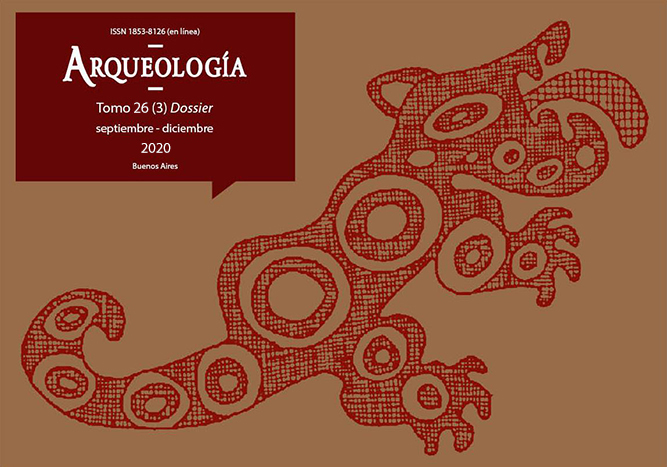Neferhotep and the goddess of the West
Abstract
Conservation work at the TT49 cult chapel has shown not only the vivid colors of its pilaster but also the columns of texts hidden, until today, by a thick layer of soot. Although Davies’s publication describes its iconography, only a few words located behind the West goddess could be read. This paper presents the current state of the pilaster after the cleaning work. Its translation is expounded for the first time after almost 3400 years of silence. Also, an interpretation of its symbolism is presented in the general context of the statues´ niche.Downloads
References
Angenot, V. (2010). Cadre et organisation de l’espace figuratif dans l’Egypte ancienne. En T. Lenain y T. Steinmetz (Eds.), Cadre, seuil, limite: la question de la frontière dans la théorie de l’art (pp. 21-50). Bruselas: La lettre volée.
Assmann, J. (2003). The Ramesside tomb and the construction of sacred space. En N. Strudwick y J. H. Taylor (Eds.), The Theban Necropolis. Past, present and future (pp. 46-52). Londres: British Museum.
Assmann, J. (2004). Die Konstruktion sakralen Raums in der Grabarchitektur des Neuen Reiches. Archiv für Religionsgeschichte, 6, 1-18.
Beinlich-Seeber, Ch. (1983). Renenutet. Wörterbuch der ägyptischen Sprache V (cols. 232- 236). Berlin: Akademie Verlag.
Bolshakov, A. (2001). Ka-Chapel. En D. Redford (Ed.), Oxford Encyclopedia of Ancient Egypt Vol. II (pp. 217-219). Oxford: Oxford University Press.
Broekhuis, J. (1971). De Goddin Renenwetet. Assen: Gorcum.
Bryan B. (2009). Memory and Knowledge in Egyptian Tomb Painting. En E. Cropper (Ed.), Studies in the History of Art, Vol. 74, Symposium Papers LI: Dialogues in Art History, from Mesopotamian to Modern: Readings for a New Century (pp. 18-39). Washington: National Gallery of Art.
Champollion, J. F. 1973 [1844]. Monuments de l’Égypte et la Nubie. Notices Descriptives I. (Collections des Classiques Égyptologiques). Genova: Éditions des Belles Lettres.
Christensen, A. (2005). Dictionary and Landscape Architecture and Construction, Michigan: McGraw Hill Education.
Davies, N. de G. (1933). The Tomb of Nefer-hotep at Thebes. Metropolitan Museum of Art Egyptian Expedition Publication 9. Nueva York: Metropolitan Museum of Art.
Fantechi, S. y Zingarelli, A. (2003). Muerte y renovación en el antiguo Egipto: las ofrendas florales. En G. Barale (Ed.), El hombre ante la muerte (temática abierta) (pp. 203-212). Tucumán. Universidad Nacional de Tucumán.
Hartwig, M. (2011). An Examination of Art Historical Method and Theory. A Case Study. En B. Backes, C. Jones y A. Verbovsek, (Eds.), Methodik und Didaktik in der Ägyptologie (pp. 313-326). Munich: Wilhelm Fink.
Jarzombek, M. (2005). Pilaster Play. Thresholds 28, 34-41.
Kampp, F. (1996). Die Thebanische Nekropole. Zum wandel des Grabgedankens von der XVIII. bis zur XX. Dynastie. Theben XIII. Mainz: Philipp von Zabern.
Leitz, C. (2002). Lexikon der ägyptischen Götter und Götterbezeichnungen, vol. IV. Orientalia Lovaniensia Analecta, 114, 686-694.
Manzi, L. y Pereyra, M. V. (2014). El banquete funerario y la bella fiesta del valle en Tebas occidental. Revista Nearco, 7(1), 238-259.
Marini, P. (2015). Renenutet: Worship and popular piety at Thebes in the New Kingdom. Journal of Intercultural and Interdisciplinary Archaeology, 2, 73-84.
Pereyra, M. V., Alzogaray, N., Zingarelli, A., Fantechi, S., Vera, S., Verbeek, Ch., Brikmann, S. y Graue, B. (2006). Imágenes a preservar en la Tumba de Neferhotep (TT49). Tucumán: Universidad Nacional de Tucumán.
Pereyra, M. V. (2011). El gran templo de Amón en la tumba de Neferhotep (TT49). Revista del Instituto de Hiatoria Antigua Oriental, 17, 17-26.
Pereyra, M. V. (2012). Espacio y tiempo ritual en la antigua Tebas. Consideraciones en torno a su representación (parte I). Revista Mundo Antigo, 1(1), 68-85.
Quaegebeur, J. (1975). Le dieu égyptien Shaï dans la religion et l’onomastique. Leuven: University Press.
Romanova, O. (2011). Contribution to reconstruction of some scenes in the chapel of prince Kawab (G 7110-7120). Studien zur Altägyptischen Kultur, 40, 339-347.
Van Walsem, R. (2005). Iconography of Old Kingdom Elite Tombs: Analysis & Interpretation, Theoretical and Methodological Aspects. Leiden: Peeters.
Wilkinson, R. (2003). The Complete Gods and Goddess of Ancient Egypt. Londres: Thames and Hudson.
Authors who publish in this journal agree to the following conditions:
- Authors retain copyright and yield to the journal right of first publication with the work registered with attribution license Creative Commons, which allows third parties to use the published always mentioning the authorship of the work and first publication in this magazine.
- Authors can make other independent and additional contractual arrangements for the non-exclusive distribution of the version of the article published in this issue (p. Eg., Inclusion in an institutional repository or publish it in a book), provided that clearly indicate that the work was published for the first time in this magazine.
- It allows and encourages the author / s to publish their work online (eg institutional or personal pages) before and during the process of revision and publication, as it can lead to productive exchanges and greater and more rapid dissemination of work published (See The Effect of Open Access).





(1)13.png)






1.jpg)
1.jpg)


13.png)
1.png)


(1)1.png)









